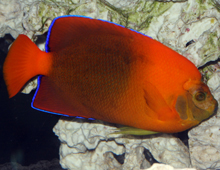Description: Clarion angelfish have a brownish- orange to vibrant orange compressed body with a brown head and small mouth. Some may have a greenish head or darker green area on the rear of their body. Just behind the head they have a broad bright orange area. Their tail fin is also orange. Juveniles differ in appearance in that they have narrow metallic blue bars on their sides and also a pair of blue bars on their head. As they grow in size, the bars become narrower and will eventually disappear altogether.
Size: Clarion angelfish reach a maximum length of about 7.9 inches (20 cm).
Behavior: They are non-migratory and occur solitarily or in small aggregations. Clarion angelfish are rather lethargic at night; active during the day.
Diet: They eat algae, sponges, tunicates and small invertebrates. They also pick off parasites and dead skin from large fish such as rays.
Reproduction: Clarion angelfish are pelagic egg layers (meaning they release large numbers of eggs and sperm into the water).
Habitat/range: This species inhabits clear water rocky reefs and walls around the Revillagigedo Islands, especially Isla Clarion. This group is made up of four volcanic islands, three being referred to as inner islands and Clarion being the most western island. Located about 240 miles southwest of Cabo San Lucas, they are part of the Mexican state of Colima. Holacanthus clarionensis have been found in the lower Gulf of California, but it is rare.
Status: Listed as Vulnerable on IUCN Red List due to their restricted range.



